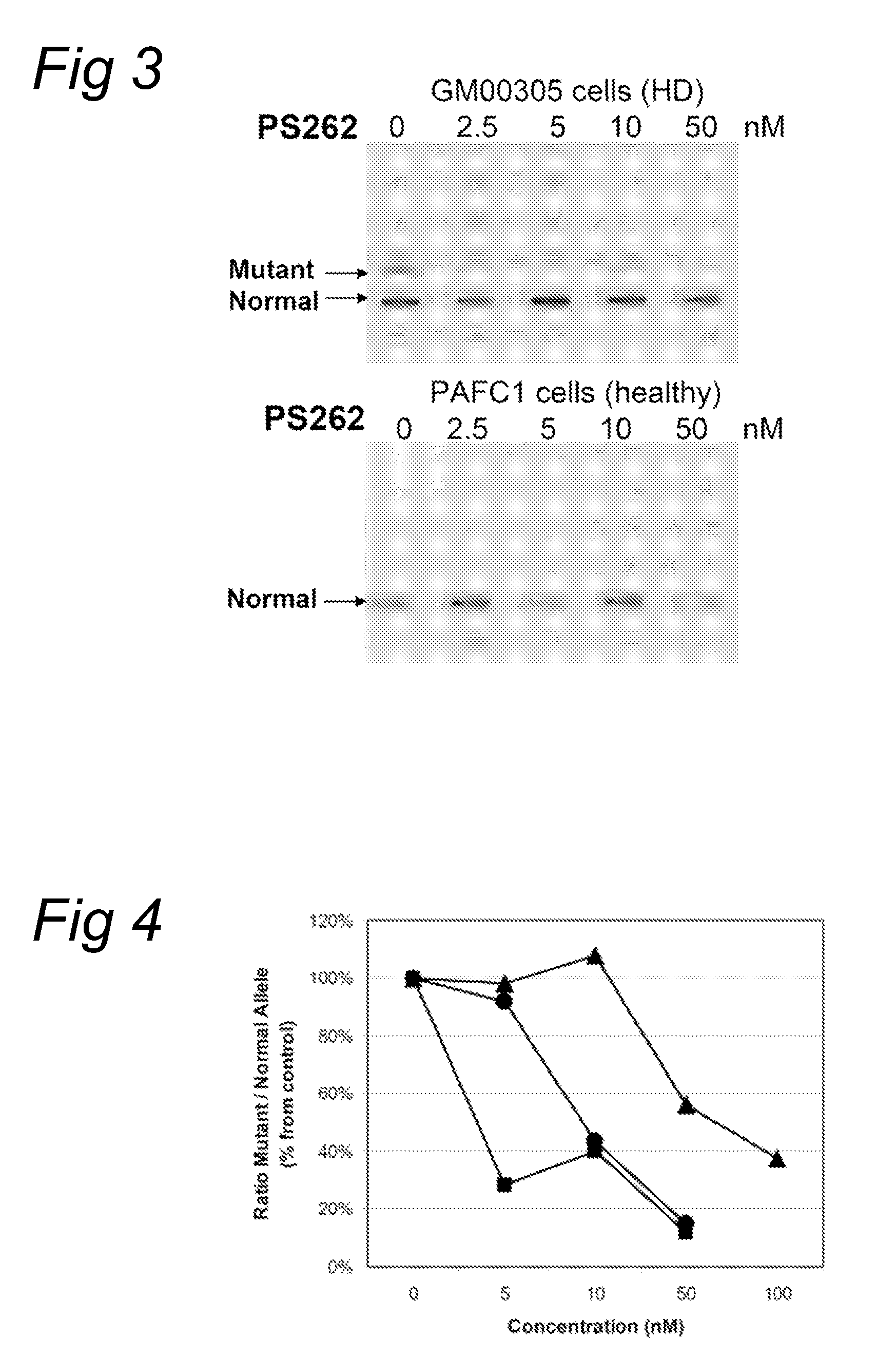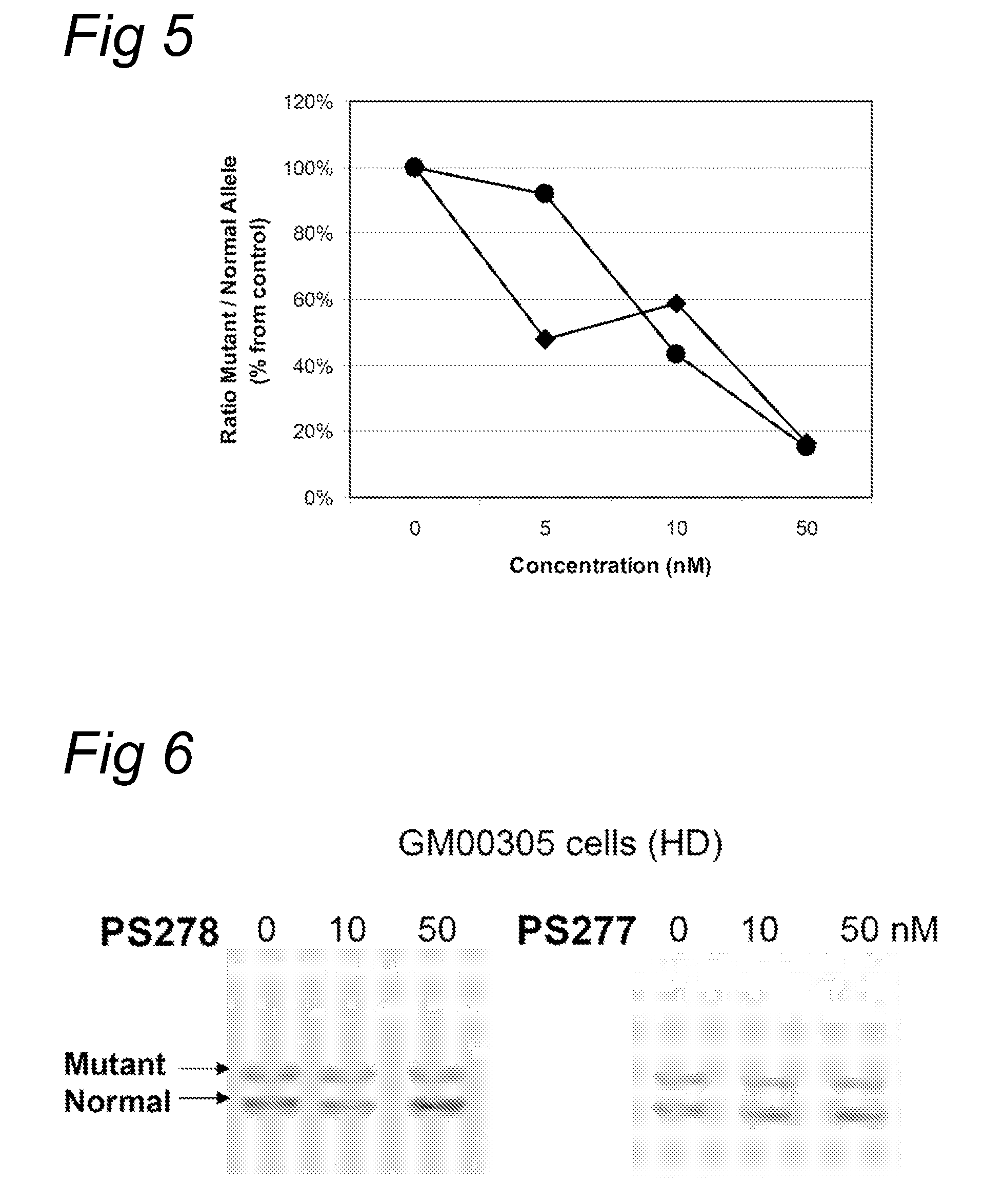Methods and means for treating DNA repeat instability associated genetic disorders
a repeat instability and genetic disorder technology, applied in the field of medicine, can solve the problems of large protein deposits, cell death, and dramatic rearrangement of other transcript splicing, and achieve the effects of reducing the number of splicing errors, and improving the quality of splicing
- Summary
- Abstract
- Description
- Claims
- Application Information
AI Technical Summary
Benefits of technology
Problems solved by technology
Method used
Image
Examples
example 1
[0079]Immortomyoblast cell lines were derived from DM500 mice using standard techniques known to the skilled person. DM500 mice were derived from mice obtained from de Gourdon group in Paris. Immortomyoblast cell lines DM500 with variable (CTG)n repeat length of approximately 500 in the DMPK gene were grown subconfluent and maintained in a 5% CO2 atmosphere at 33° C. on 0.1% gelatin coated dishes. Myoblast cells were grown subconfluent in DMEM supplemented with 20% FCS, 50 μg / ml gentamycin and 20 units of γ-interferon / ml. Myotube formation was induced by growing myoblast cells on Matrigel (BD Biosciences) coated dishes and placing a confluent myoblast culture at 37° C. and in DMEM supplemented with 5% horse serum and 50 μg / ml gentamycin. After five days on this low serum media contracting myotubes arose in culture and were transfected with the desired oligonucleotides. For transfection NaCl (500 mM, filter sterile), oligonucleotide and transfection reagens PEI (ExGen 500, Fermentas)...
example 2
[0082]Fibroblasts (GM 00305) from a male patient with Huntington's Disease were obtained from Coriell Cell Repository (Camden, N.J., US) and cultured according to the accompanying instructions and standard techniques known to the skilled person in the art. Huntington patients carry one healthy and one disease-causing allele of the Huntington gene resulting in the expression of both mRNAs with respectively a normal number and an expanded number of (CAG) repeats, respectively. Control fibroblasts (PAFC1) were obtained from a healthy volunteer with normal repeat length in both huntingtin alleles.
[0083]The fibroblasts were transfected with oligonucleotides PS57 (SEQ ID NO:3), PS261 (SEQ ID NO:6), PS262 (SEQ ID NO:7), PS277 (SEQ ID NO:8) and PS278 (SEQ ID NO:9), all directed to the complementary (CAG) triplet repeat in Huntingtin transcripts. A transfection was applied at several concentration levels using PEI as indicated by the manufacturer. Four hours after the start of treatment, the...
example 3
[0087]According to the methods described in example 1, myotubes derived from DM500 cells were treated with 200 nM oligonucleotide PS259 (SEQ ID NO:20) (with an alternative starting nucleotide compared to PS58 (SEQ ID NO:4)) or 200 nM oligonucleotide PS261 (SEQ ID NO:6) (comprising inosine (I) nucleotides instead of adenosine(A)). The hDMPK signal (solid bars) after treatment has been depicted in FIG. 8. demonstrating effective inhibition by the oligonucleotides.
PUM
| Property | Measurement | Unit |
|---|---|---|
| radioactive | aaaaa | aaaaa |
| fluorescent | aaaaa | aaaaa |
| nucleic acid | aaaaa | aaaaa |
Abstract
Description
Claims
Application Information
 Login to View More
Login to View More - R&D
- Intellectual Property
- Life Sciences
- Materials
- Tech Scout
- Unparalleled Data Quality
- Higher Quality Content
- 60% Fewer Hallucinations
Browse by: Latest US Patents, China's latest patents, Technical Efficacy Thesaurus, Application Domain, Technology Topic, Popular Technical Reports.
© 2025 PatSnap. All rights reserved.Legal|Privacy policy|Modern Slavery Act Transparency Statement|Sitemap|About US| Contact US: help@patsnap.com



